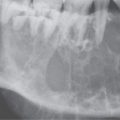ORAL CAVITY AND FLOOR OF THE MOUTH: MALIGNANT TUMORS
KEY POINTS
- Computed tomography and magnetic resonance imaging are critical to the medical decision making process in oral cavity carcinoma due to their ability to show the deep soft tissue extent of the primary, bone involvement, perineural spread, carotid fixation, and related retropharyngeal and cervical adenopathy.
- Computed tomography and magnetic resonance imaging are useful in excluding oral cavity cancer as a cause of symptoms that might be referable to such a cancer and in patients with parapharyngeal or other deep facial space– origin masses that might raise the concern of a submucosal cancer.
- Both anatomic imaging with computed tomography or magnetic resonance and physiologic imaging with fluorine-18 2-fluoro-2-deoxy-D-glucose positron emission tomography (FDG-PET) might be useful in posttreatment surveillance and detection of recurrence at its most curable state.
- A detailed knowledge of the regional anatomy of the oral cavity is necessary to accomplish these goals.
About 95% of oral cavity malignant tumors are squamous cell carcinoma (SCCA). Malignant lymphoma (Chapter 27), minor salivary gland epithelial carcinoma (Chapter 22), and sarcomas (Chapter 35) are all unusual cancers in this region and account for the majority of the small group of other malignancies that may arise primarily in the oral cavity. These trends exclude tumors of maxillary or mandibular origin; those are discussed in chapters on sinonasal (Chapters 89–92) and mandibular/dental (Chapters 99 and 100) tumors.
Patients with SCCA tumors of the oral cavity usually present with obvious mucosal masses that have predictable spread patterns based on their site of origin (Figs. 200.1 and 200.2). Neoplasms such as minor salivary gland malignancies may present with submucosal masses or pain (dental related); trismus; or other functional complaints related to speech, swallowing, or mastication without a visible mass (Figs. 200.3 and 200.4). They virtually never present with cervical adenopathy of uncertain etiology. These presenting circumstances make oral cavity cancer a consideration in many, predominantly adult, patients who seek care for oral cavity problems.
ANATOMIC AND DEVELOPMENTAL CONSIDERATIONS
Applied Anatomy
The critical anatomic knowledge necessary for the evaluation of oral cavity malignancies is summarized here since it is fairly complex. The more detailed anatomy of this region and the related nasal cavity (Chapter 78), oropharynx (Chapter 190), suprahyoid neck and related deep tissue spaces (Chapter 142), submandibular space (Chapter 175), and regional lymphatic pathways (Chapters 149 and 157) are reviewed in chapters indicated in parentheses. A detailed working knowledge of all of this anatomy is necessary to evaluate images of patients with known or suspected oral cavity cancer if the evaluation of the images is expected to contribute measurably to medical decision making.
Lips
The lips are covered by skin externally and mucosa internally. In this chapter, with regard to oral cancer, the lip begins at the vermilion or mucocutaneous junction. The orbicularis oris muscle, part of the superficial musculoaponeurotic system (SMAS) of the face, which makes up part of its substance, is innervated by the facial nerve. The blood supply is the labial artery from the facial artery. The sensory nerve supply to the lower lip is via the mental nerve, which is a branch of the inferior alveolar nerve. The sensory nerve of the upper lip is the infraorbital branch of the maxillary nerve.
Floor of the Mouth
The floor of the mouth (FOM) is a U-shaped area beneath the oral tongue. Its posterior border is the anterior tonsillar pillar. Computed tomography (CT) and magnetic resonance (MR) images through the FOM and oral tongue show the FOM as a roughly symmetric region separated by a midline fatty lingual septum. The lingual septum is a useful landmark, but it is not able to restrict tumor spread. Horizontally, continuous spaces between the inferior margin of the genioglossus and geniohyoid muscles and the space below the geniohyoid muscle are conduits for spread of disease across the midline.
The genioglossus and geniohyoid muscles forming the medial boundary of the sublingual space and the mylohyoid muscle forming its lateral boundary are prominent imaging landmarks. Coronal images most graphically show the depth of the FOM and its relationship to the submandibular space. Those images show the mylohyoid muscle separating the submandibular space and sublingual space as the muscle extends from the mylohyoid ridge on the mandible to the hyoid bone. On axial and coronal sections, the sublingual spaces usually appear symmetric. These spaces contain glandular and fatty tissue that is easy to distinguish from the related muscles both on CT and MR.
The lingual vasculature is consistently visible coursing through these spaces. The hypoglossal nerve and lingual nerves are not normally visible; however, their expected course in the FOM is predictable based on their relationship to the hyoglossus muscle within the FOM (Figs. 196.3C–E and 196.2E–G). The hyoglossus muscle is routinely seen on axial and coronal images as a band of variable thickness muscle tissue essentially bisecting the glandular and fatty tissue of the sublingual space. The lingual nerve and submandibular duct lie in close proximity to the hyoglossus muscle along with the sublingual gland. The lingual artery and vein course medial to the hyoglossus muscle with the hypoglossal nerve in close proximity constituting the main neurovascular bundle of the tongue.
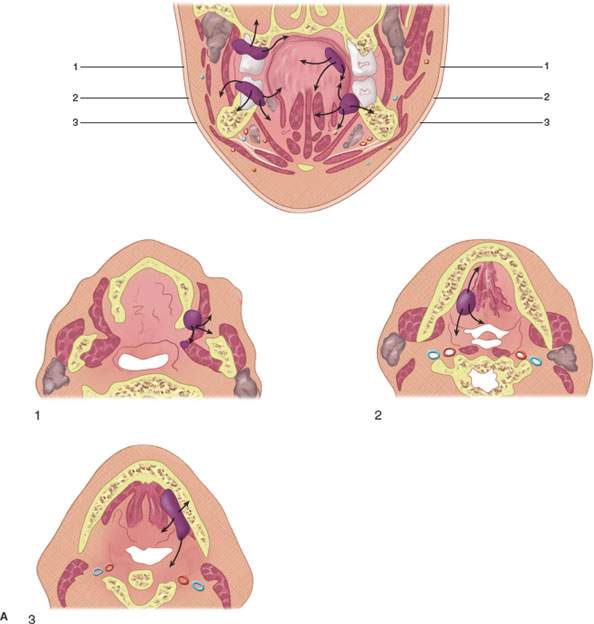
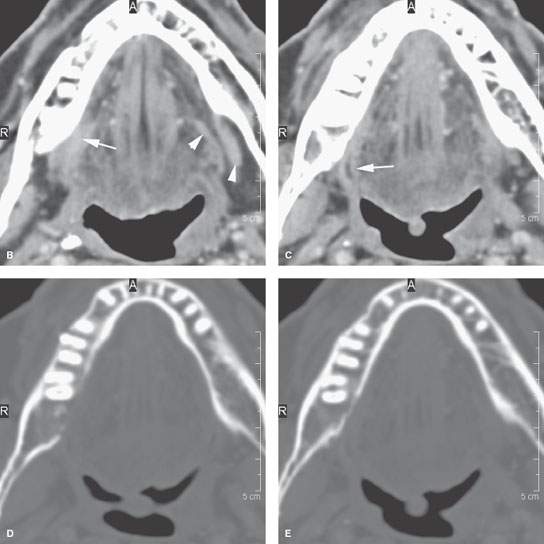
FIGURE 200.1. Oral cavity cancers, depending on their site of origin, spread in a predictable manner, summarized in the diagram in (A). Figure 195.3A–C should also be reviewed since there is some crossover between spread patterns of oropharyngeal anterior tonsillar pillar cancer and cancers that arise in the posterior aspect of the oral cavity. B–E: A patient with a cancer arising in another border zone between the oropharynx and the oral cavity, sometimes referred to as the lingual alveolar sulcus, with its underlying anatomic features presented in Figure 195.6A,B. This border zone lies between the oropharyngeal glossotonsillar sulcus and posterior floor of the mouth. The contrast-enhanced computed tomography study in (B) shows the infiltrating tumor along the posterior oral tongue and within the lingual alveolar sulcus as it spreads along the mylohyoid and hyoglossus muscles (arrow). Those muscles are shown in their normal state on the left side (arrowheads). In (C), the continued mucosal extent of the lesion is visible. The bone erosion seen in (D) and (E) was not anticipated clinically and resulted in a segmental mandibular resection being added to the treatment plan.
The lingual and buccal surfaces of the mandible are very well seen on axial and coronal images. Bony landmarks include the mandibular foramen, the mental foramen, and the genial tubercles for the insertion of the genioglossus and geniohyoid muscles. The muscles of mastication, attached both medially and laterally with their encompassing fascia, form the masticator space. The alveolar ridge is currently effectively evaluated by multidetector computed tomography (MDCT) with various multiplanar reformation techniques.
Oral Tongue
The circumvallate papillae are the boundary between the oral tongue and tongue base, with the latter being part of the oropharynx (Chapter 190). This row of papillae is at about the level where the anterior tonsillar pillar joins the tongue.
The oral tongue arterial supply is from the lingual arteries. The lingual septum restricts anastomosis across the midline; thus, sacrifice of both lingual arteries results in an increased risk for oral tongue necrosis and essentially assures tongue base necrosis.
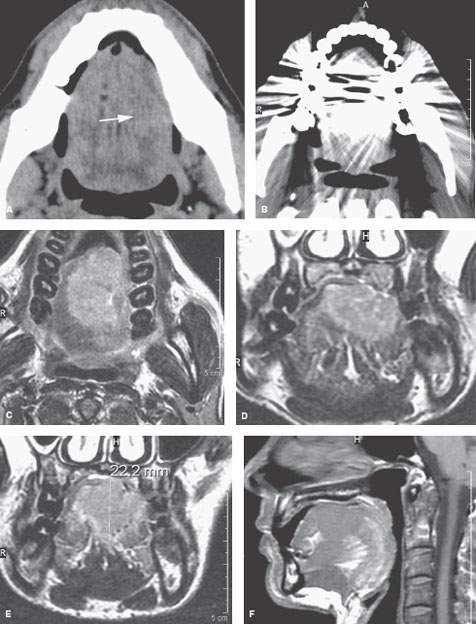
FIGURE 200.2. Imaging can be useful in mapping the extent of mucosal-origin tumors. In oral tongue cancers, magnetic resonance imaging (MRI) may be preferred to computed tomography (CT) study for that purpose. In (A), a CT study shows a vague infiltrating oral tongue cancer on one section, but in (B), artifacts related to dental appliances make the CT study nondiagnostic with regard to the extent of the primary tumor within the oral tongue. The MRI study in the same patient provides a very clear assessment of the patient’s oral tongue cancer, including its depth of penetration into the oral tongue and involvement of the floor of the mouth as well as its relationships to the lingual neurovascular bundle of the tongue as seen in the T2-weighted images in (C) through (E) and the T1-weighted sagittal image in (F).
The sensory nerve to the oral tongue is the lingual nerve, which is a branch of V3. The hypoglossal nerve is the motor supply to the tongue.
The tongue has inconstant lingual lymph nodes. The lymphatic collecting trunks from the anterior tongue can terminate directly in level 2 or 3 nodes, while the posterior tongue drains predominantly to level 2A. A connecting trunk to level 1A is rare. The outer third of the oral tongue drains to the ipsilateral levels 1B and 2A. The inner two thirds of each side of the tongue vessels have pathways to both sides of the neck. This means that as tumor extends 5 mm from the lateral margin of the tongue, contralateral nodal metastatic risk increases.
The oral tongue is only attached loosely to the FOM. The transition between the FOM and ventral surface of the tongue is difficult to identify on axial sections. This relationship is demonstrated on coronal images. The oral portion of the tongue has a fairly homogeneous appearance on CT, mainly that of muscle laced with fat. The interleaved intrinsic muscle bundles and fat are usually better seen on MR, but this is not clinically important. The hyoglossus and styloglossus muscles interdigitate in the posterior aspect of the tongue. The styloglossus muscle is a prominent landmark as it penetrates the substance of the posterior aspect of the tongue. It does this after traveling through the parapharyngeal fat from its origin on the styloid process. These muscles and spaces medial and lateral to the styloglossus muscle are areas where tumor can spread into the soft tissues of the neck, carotid sheath, and toward the skull base.
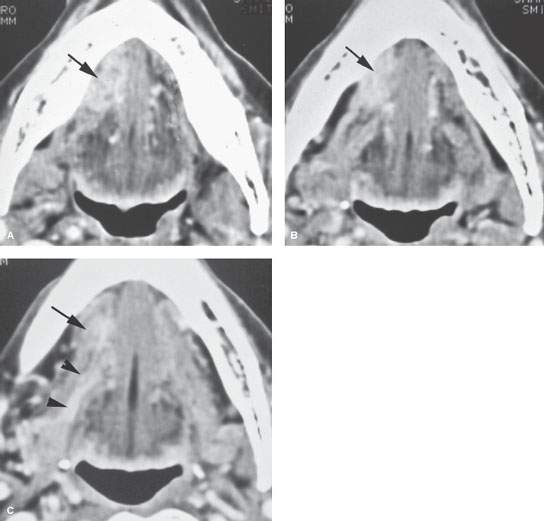
FIGURE 200.3. Cancers will occasionally arise entirely beneath normal mucosa in the oral cavity. The extent can only be fully appreciated on good-quality diagnostic imaging. These submucosal cancers frequently arise in minor salivary gland tissue. A–C: Contrast-enhanced computed tomography study in a patient with a submucosal mass in the floor of the mouth due to an adenoid cystic carcinoma arising in the sublingual gland (arrows) and infiltrating deep into the floor of the mouth with evidence of perineural and/or periductal spread of tumor (arrowheads in C).
Buccal Mucosa
The buccal mucosa covers the inner aspect of the cheeks and lips. It transitions to the gingiva and ends posteriorly at the retromolar trigone. The upper and lower gingivobuccal sulci are mucosal-lined areas evaluated far more definitively by physical examination than by imaging. A “puffed cheek” CT acquisition has been suggested to improve the evaluation of the gingival and buccal mucosa, but this is rarely, if ever, done in practice (Fig. 196.1H,I). These areas are normally collapsed on axial and coronal images. They are the areas lining the inner surface of the lips and cheeks and are best recognized when bordered on their deep surface by the buccinator muscle. The buccal fat pad of the buccinator space lies lateral to this muscle, and that fat pad is contiguous with the retroantral fat of the infratemporal fossa.
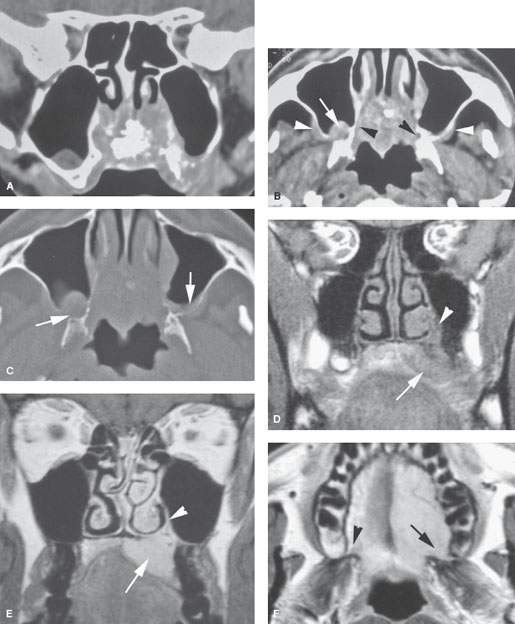
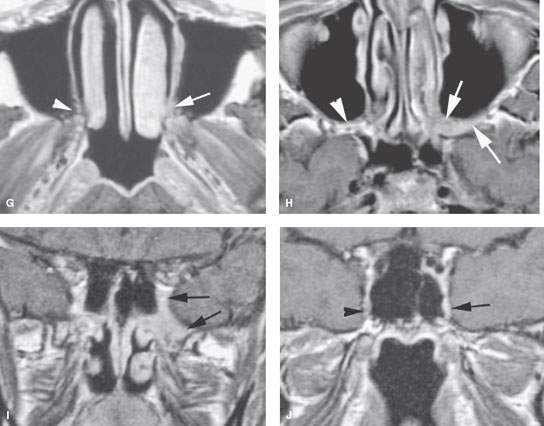
FIGURE 200.4. Submucosal cancers can also arise from the hard palate. These are difficult to assess in their entirety clinically. A–C: Patient 1 with an adenoid cystic carcinoma presenting as a hard palate mass with no mucosal lesion in the nasal cavity, so its origin was presumed to be from minor salivary glands along the hard palate based on the spread pattern it exhibited along the palatine neurovascular channels. In (B), the tumor can be seen infiltrating the greater palatine neural foramina (black arrowheads) and growing within the lower pterygopalatine fossa (white arrow) to infiltrate along the distal branches of the posterior superior alveolar nerves where those nerves travel along the posterior wall of the maxillary sinuses (white arrowheads). In (C), the bony destructive changes (arrows) associated with the findings in (B) are illustrated. D–J: Patient 2 with a mucoepidermoid carcinoma of the hard palate arising entirely beneath intact mucosa. In (D), the non–contrast-enhanced T1-weighted (T1W) image shows the tumor infiltrating the soft tissues of the hard palate (arrow) and extending up the greater palatine neural foramen. In (E), the contrast-enhanced T1W image shows the mass to enhance homogeneously (arrow), confirming the spread up the greater palatine neural foramen. In (F), the axial image shows the tumor involving the entire hard palate and infiltrating into the greater palatine neural foramen (arrow) compared to the normal foramen on the opposite side (arrowhead). In (G), the tumor continues its extension up the greater palatine neural canal (arrow) compared to the normal opposite side, and in (H), the cancer reaches the upper pterygopalatine fossa (arrows) compared to the normal side (arrowhead). The T1W coronal image in (I) shows the tumor infiltrating the pterygopalatine fossa and the inferior orbital fissure (arrows), and in (J), the continued spread along the second division of the trigeminal nerve (arrow) compared to the normal side (arrowhead) shows that the tumor was not amenable to gross total resection.
Upper and Lower Alveolar Ridges, Retromolar Trigone, and Hard Palate
The retromolar trigone is a small triangular mucosal surface covering the ascending ramus behind the third molar. It is continuous superiorly with the maxillary tuberosity. These areas are connected beneath the mucosa by the tendinous pterygomandibular raphe. The raphe attaches to the pterygoid hamulus and the posterior mylohyoid ridge of the mandible. It is the common tendon of the buccinator, orbicular oris, and superior constrictor muscles (Fig. 200.5). The deep relationships of the raphe place it and the retromolar trigone at the borders of the oral cavity, oropharynx, nasopharynx, and FOM. The fatty pterygomandibular space containing the lingual and dental nerves lies just medial to the pterygomandibular raphe between the medial pterygoid muscle and the mandibular ramus.
The alveolar ridges occupy the surfaces of the mandible and maxilla along the dental arches, with their appearances varying greatly depending on the state of the dentition in an individual patient.
Lymphatics
Neurovascular bundles associated with each of the regions in the FOM are for the most part described above. Cancers in this region may also spread superiorly and laterally to involve the fat posterior to the maxillary sinus and at that point grow along the posterior superior alveolar neurovascular bundles that travel in that fat pad (Figs. 200.4–200.6).
Lymphatics in this region generally drain to levels 1 and 2. Some direct connections to level 3 and upper level 2 nodes that lie above the level of the digastric posterior belly (sometime called prestyloid nodes) are present as well (Fig. 200.7). Some of the unique features of the lymphatic drainage of this region are discussed previously in this section.
IMAGING APPROACH
Techniques and Relevant Aspects
General Examination Technique
Oral cavity cancer is studied generally in the same manner as that of the oropharynx (Chapter 195). Some strategic alterations in approach from that used in the oropharynx are useful.
Oral cavity CT and magnetic resonance imaging (MRI) always include axial views as well as coronal sections as a routine. Coronal viewing is essential for many studies, while sagittal images are used for some cancer patients and mainly in those cases when there is a significant concern about depth of invasion of the FOM and sometimes to display an unusually complex relationship between the pathology and the FOM, tongue base, mandible, and spaces of the suprahyoid neck or in the unusual instances when tumors approach the skull base (Appendixes A and B).
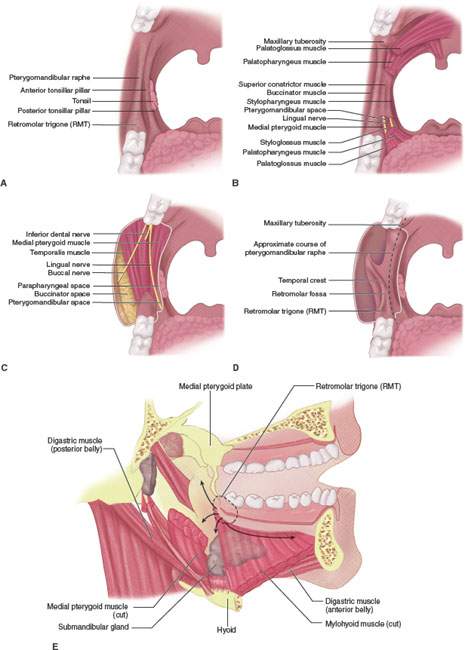
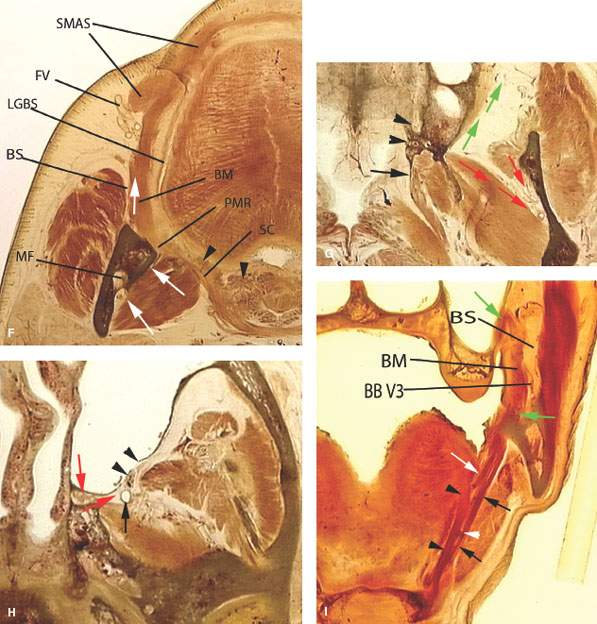
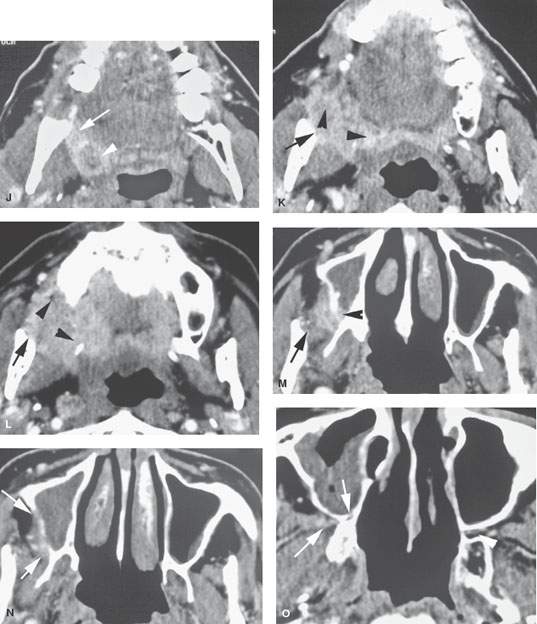
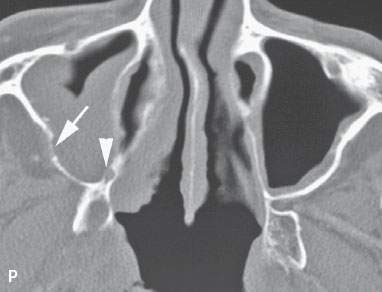
FIGURE 200.5. A–D: Oral cavity cancers have very significant spread patterns based on the anatomy of the pterygomandibular raphe and the mucosal relationships of the raphe as well as its deep relationships. E: Additional important relationships are shown, where spread patterns of a lesion in the retromolar trigone and lingual alveolar sulcus region along the pathways created by the pterygomandibular raphe and mylohyoid muscles attachments are demonstrated. F–I: Anatomic sections emphasizing the structural relationships that explain how cancers in this area often show clinically occult spread patterns that greatly alter the surgical approach. In (F), there is an emphasis on the relationships of the pterygomandibular raphe (PMR) as it is formed by the confluence of the superior constrictor (SC) and buccinator muscles (BM). These structures bear important relationships to the lower gingivobuccal sulcus (LGVS), the buccal space (BS), and superficial musculoaponeurotic (SMAS) layer of the face. The diagram also shows the potential for tumor to spread along the facial vessels (FV) and adjacent nerves as they relate to the SMAS layer. White arrows show potential spread patterns anteriorly along the buccinator muscle and a potentially devastating pathway more posteriorly along the inner surface of the mandible (white arrows) since spread along the mandible medial surface can create access to the mandibular division of the trigeminal nerve within the mandibular foramen. The black arrows indicate the presence of minor salivary glands that give rise to glandular carcinomas presenting in the retromolar trigone and posterior oral cavity region, often beneath intact mucosa. In (G), an anatomic section at the superior aspect of the pterygomandibular raphe shows the close relationships between the hook of the hamulus at the approximate position of the black arrow. The greater and lesser palatine foramina are shown by the black arrowheads. Potential pathways of tumor spread that reach this area along the pterygomandibular raphe or along the temporalis muscle and tendon as they attach to the mandible are shown by the red arrows. The growth within the buccal space is shown by the green arrows. In (I), coronal anatomic sections show the relationships between the muscular attachments and adjacent bony structures. The buccinator muscle (BM) attaches both along the inferior maxilla and mandible (green arrows). The buccal space (BS) contains potential neural and vascular spread conduits such as the buccal branch of the mandibular nerve (BBV3). The mylohyoid muscle (black arrows) and hyoglossus muscle (black arrowheads) create planes within the floor of the mouth that separate the lingual (white arrow) and hypoglossal (white arrowhead) nerves, which also are potential conduits of tumor spread. J–O: Contrast-enhanced computed tomography in a patient with a hybrid anterior tonsillar pillar and retromolar trigone carcinoma to illustrate the importance of the anatomic spread patterns just described and how these can lead to clinically occult cephalad spread along posterior superior alveolar vessels and nerves. Such spread will require the extension of surgery for such an oral cavity cancer to include a posterior maxillectomy in addition to the more common resection of the maxillary tuberosity as the upper margin for the “standard” operation on these cancers. In (J), the tumor involves the anterior tonsillar pillar (arrowhead) and extends toward the pterygomandibular raphe (arrow). In (K), the tumor has spread along the anterior tonsillar pillar to the retromolar trigone region (arrowheads) involving the pterygomandibular raphe (arrow). In (L), there is continued spread along the pterygomandibular raphe (arrow) to involve the alveolar ridge, hard palate, and soft palate at the level of the maxillary tuberosity and hook of the hamulus, which is the highest-most aspect of the pterygomandibular raphe attachment. In (M), there is extension of tumor to involve the mandible along the attachment of the temporalis tendon, an upward extension from the pterygomandibular raphe, and invasion along the posterior wall of the maxillary sinus (arrowhead), with that invasion continuing in (N) along the posterior wall of the maxillary sinuses and distal branches of the posterior superior alveolar neurovascular bundle (arrows). That spread continues cephalad as seen on (O) with involvement of the greater palatine canal and along the posterior superior alveolar vessels (arrows). P: Bone erosion related to the spread along the posterior superior alveolar vessels (arrow) and the greater palatine neurovascular bundles (arrowhead) is shown.
For CT acquisitions, section thickness should be 0.5 to 1.0 mm through the area of main interest so that reformations, when necessary, are of adequate spatial resolution. Intravenous contrast is always used except when a CT is being done solely to look for bone erosion. Specific CT cancer protocols are presented in Appendix A.
Any CT study of the oral cavity and FOM must be viewed and/or filmed at both soft tissue and bone windows. Additional reconstructions with a bone algorithm are often essential in cancer protocols (Appendix A) for this region. Potentially significant bone changes can be missed when viewing bone windows only on images reconstructed with a soft tissue algorithm, so additional 0.5 to 0.75 mm slice thickness reconstructions with bone windows are routine parts of protocols in this region.
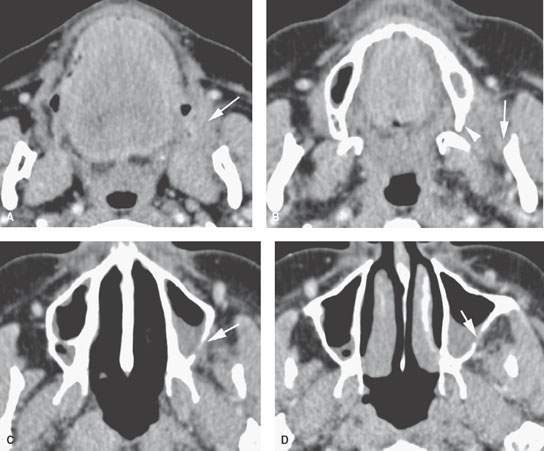
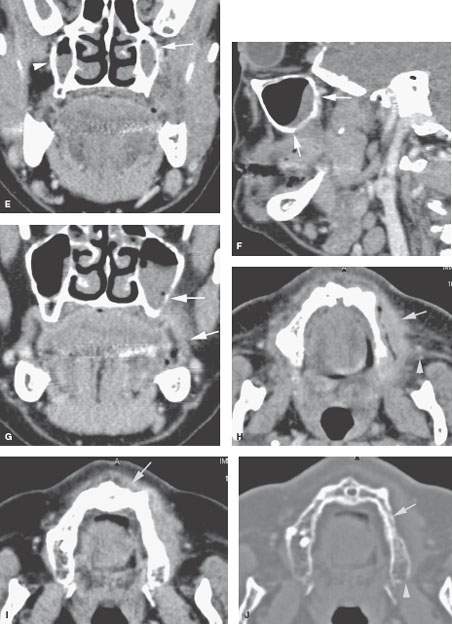
FIGURE 200.6. Two patients with gingivobuccal sulcus cancers showing how these lesions may spread in a pattern directed by the anatomy demonstrated in Figure 200.5. A–G: Patient 1. The upper gingivobuccal carcinoma grossly infiltrates the buccal space (arrow in A). In (B), there is continued spread in the buccal space (arrow) occurring along the temporalis tendon (arrow) and eroding the maxillary tuberosity (arrowhead). In (C), there is continued cephalad spread along the posterior wall of the maxillary sinus eroding bone and involving the course of the distal posterior superior alveolar vessels that spread, continuing even more cephalad along those vessels and nerves as seen in (D). In (E), the coronal reformatted image shows the extent of cephalad spread along the maxilla and related vessels and nerves (arrow) compared to the normal side (arrowhead). This extent along the sinus wall to a relatively cephalad limit is shown between the arrows, markedly extending the planned posterior maxillectomy. In (G), a more anterior coronal reformatted image shows the tumor growing along the buccinator muscle to invade the maxilla infrastructure (arrows). H–J: Patient 2. Contrast-enhanced computed tomography study to illustrate how imaging can help to more precisely plan resection of what was felt to be a relatively limited alveolar ridge and gingival-origin carcinoma. In (H), the primary tumor infiltrates the entire gingivobuccal sulcus and extends laterally to involve the superficial musculoaponeurotic system layer (arrow). There is also a tendency to involve the distal parotid duct (arrowhead). This lateral extension raises the issue of possible through and through resection of the cheek with flap repair as an oncologically optimal approach. In (I), unanticipated deep spread anteriorly was noted medial to the projection of the canine tooth (arrowhead). Such spread also places distal infraorbital nerves at risk for perineural spread. In (J), the relatively indolent pattern of bone destruction along the alveolar ridge (arrow) and the more subtle erosion of the maxillary tuberosity are shown.
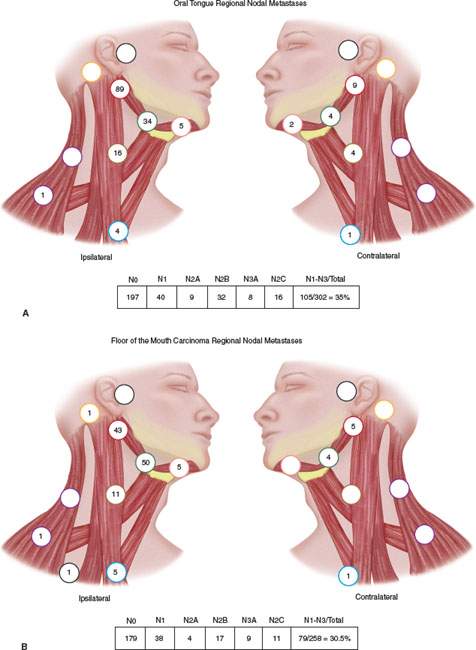
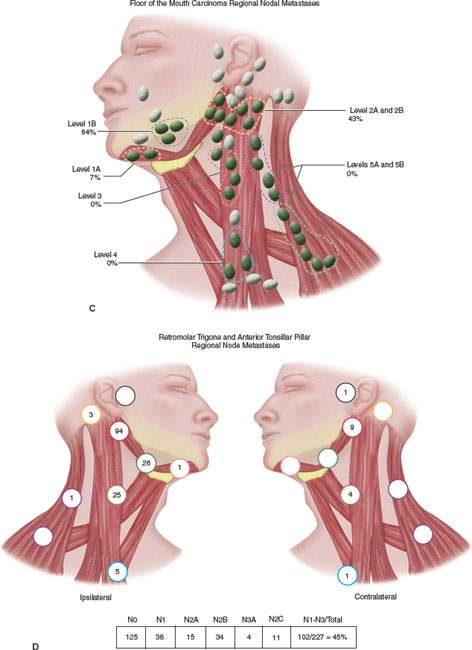
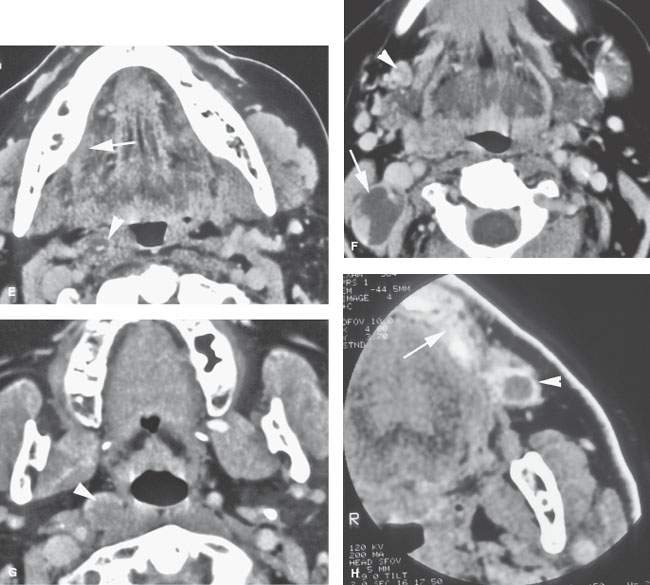
FIGURE 200.7. A–D: Diagrams modified from the work of Lindberg2 and Byers et al.3 illustrating that the expected pattern of cervical lymph node metastases from particular head and neck squamous cell primary sites has been well known for about 40 years. Such prior knowledge must be taken into account when there are departures from traditional methods of treatment that have been based on this core knowledge for many years. These patterns help to explain what downside risk might exist in “modernizing” treatment plans. In addition to cervical lymph node tendencies demonstrated in (A) through (D), retropharyngeal and facial nodes must be considered in treatment planning for oral cavity cancers. E–G: Patient 1, with a very limited posterior oral cavity tumor barely visible on imaging (arrow), also had an area suspicious for a retropharyngeal lymph node (arrowhead). Retropharyngeal lymph node metastasis from oral cavity cancer is very rare. As seen in (F), this patient also had a positive level 1 node and a positive level 2B node, which is a fairly typical spread pattern. A retropharyngeal lymph node was confirmed in (G). This node was removed at the time of surgical excision of the primary tumor. If this node had not been noted, the patient would have likely failed therapy with little chance for successful salvage. H: Patient 2. Contrast-enhanced computed tomography of a limited buccal mucosal cancer (arrow) with palpable thickening in the cheek felt to be due to the primary tumor shown here to actually be a metastatic buccal space lymph node of the facial lymph node group (arrowhead).
Iodinated contrast is used in all cancer CT studies in this region. If iodinated contrast cannot be used, then MRI should be done and complementary non–contrast-enhanced CT used for bone detail, if necessary. It is very important not to begin scanning too early in the contrast injection. Peak enhancement of most cancers relative to normal tissue may be missed if scanning begins too early.1
For MRI, fat-suppressed imaging can lose critical information in the anterior oropharynx due to field distortion susceptibility artifacts generated by dental appliances (Chapters 1 and 3). Fat suppression should generally not be the sole T1-weighted postcontrast acquisition unless it can be confirmed that no such artifacts will occur. Specific MR cancer protocols are presented in Appendix B.
Pros and Cons
Diagnostic imaging is used for the following issues in almost all oral cavity cancers that come to imaging:1 evaluation of the mandible and teeth,2 deep extent of the primary tumor,3 perineural and perivascular spread, and the status of the regional lymph nodes.4
The status of the patient’s dentition remains most simply handled by a combination of orthopantomography and standard dental views. If CT is anticipated, then MDCT with proper protocols can provide those data. MDCT is certainly sufficient for surgical planning decisions such as sufficiency of bone stock present to allow for a rim resection. Standard dental radiographs are also valuable to assess possible bone erosion involving the mandibular and maxillary alveolar ridge. Dedicated cone beam volume computed tomography can now be used for this assessment as well. MDCT with proper protocols (submillimeter section acquisition) is the best study for evaluating the lingual and buccal surfaces of the mandible (Figs. 200.8–200.10).
Reconstructed images for mandibular assessment should not exceed 1 mm when looking at the buccal and lingual surfaces, and even thinner SLT should be used when necessary to evaluate the alveolar ridge. Interference from amalgams or other dental appliances can be avoided because the gantry can be angled to miss most of these objects. Deeper implants can significantly still degrade the study. Data acquisition should be made parallel to the body of the mandible so as to avoid distorting the anatomic relationships ideally necessary for precise treatment planning. This is an important technical detail that must not be omitted by radiologists helping with care of cancers in this region. Such detailed imaging can also help in evaluating the extent of lesions relative to the inferior alveolar canal.
MR is of value in detecting the spread of tumor within the mandibular marrow space; however, when oral cavity cancer invades the mandible and maxilla, it typically produces a geographic area of bone destruction as seen on CT. The tumor involvement of the mandibular marrow space is normally confined to this discreet area of invasion, so MR is seldom necessary for delineation of more widespread mandibular involvement. MR can be used to evaluate the extent of marrow space infiltration and proximal spread along the inferior alveolar and mandibular nerves in highly selected cases (Figs. 200.8–200.10). Routine use of MR to determine the presence and extent of mandibular involvement is not wise. MRI is virtually never acceptable to exclude bone erosion along the lingual and buccal surface of the mandible. MRI should be used with great caution in lieu of CT since the pattern of bony changes as seen on CT may suggest a diagnosis other than cancer.
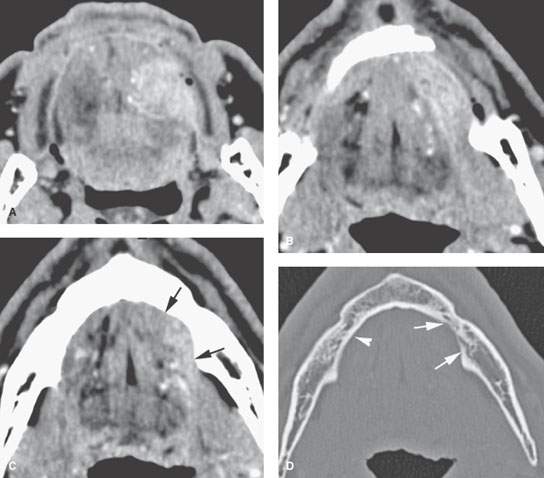
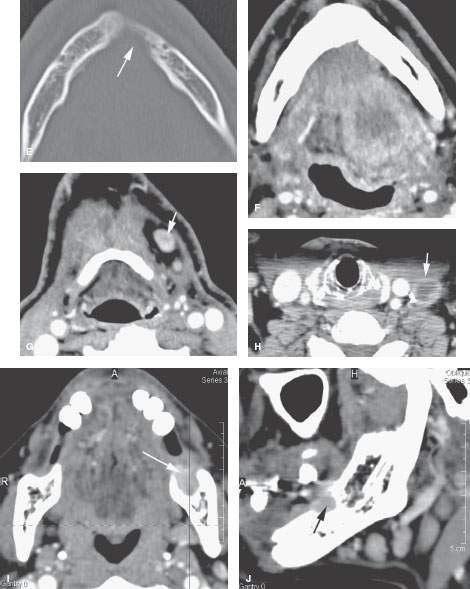
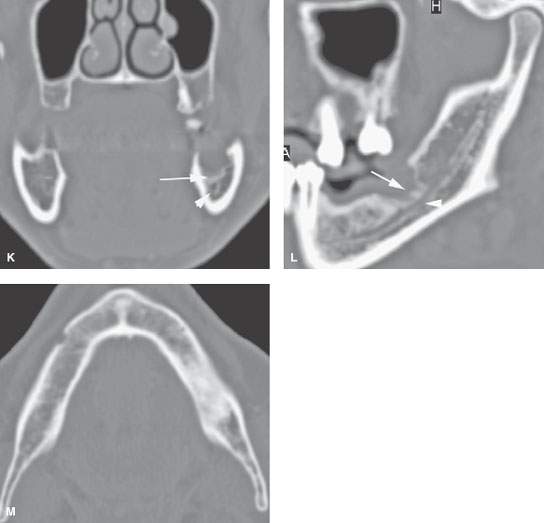
FIGURE 200.8. Evaluation of bone is extremely important in many oral cavity cancers. In particular, it is an important factor in evaluating oral tongue cancers that involve the floor of the mouth (FOM), FOM cancers, and those arising along the retromolar trigone as well as those of alveolar ridge and buccal mucosa origin. Three patients illustrate various aspects of oral cavity cancer bone invasion. A–H: Patient 1. Contrast-enhanced computed tomography (CT) study showing a primary of the oral tongue, which in (A) and (B) is seen to extend to the upper FOM and then in (C) to penetrate deep into the FOM adjacent to the mandible with its extent relative to the lingual plate of the mandible shown by the arrowheads in (C). In (D), there is saucerization of the lingual plate of the mandible (arrows) without frank bone erosion but an obvious thinning cortex (arrows) compared to the normal opposite side (arrowhead). At surgery, it was determined that the periosteum had limited the growth of the tumor, so a marginal mandibulectomy was attempted. In (E), failure at the bony margin (arrow) is present. The extensive failure in the FOM is shown in (F) and then related adenopathy in (G) and (H). Note that despite the neck dissection, a residual node in level 1 (arrow) contained metastatic disease as well as the node in level 4, which was not included in the neck dissection limited to levels 1, 2, and 3. The neck specimen was originally negative. I–L: Patient 2. Contrast-enhanced CT study in a clinically verrucous-appearing retromolar trigone primary appearing to be limited to the retromolar trigone as seen in (I) and (J) (arrows). Coronal and sagittal reformatted images in bone windows show the bone erosion to extend well into the mandibular body (arrow), having a fairly well corticated chronically eroded margin separate from the inferior alveolar canal (arrowhead). This bone invasion was well beyond the alveolus and required segmental resection. (NOTE: This illustrates how squamous cell carcinoma of the oral cavity bone erosion will typically be in a relatively geographic area that conforms to the margin of the cancer. That pattern is also illustrated in Patient 1.) M: Patient 3 had a carcinoma of the alveolar ridge. There was extensive sclerosis of bone, which can be associated with invasion. In this case, it was due to condensing osteitis due to long-standing dental disease. There was no bone erosion.

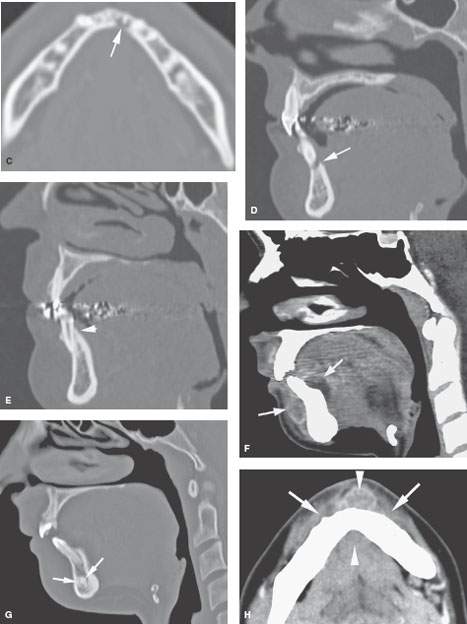
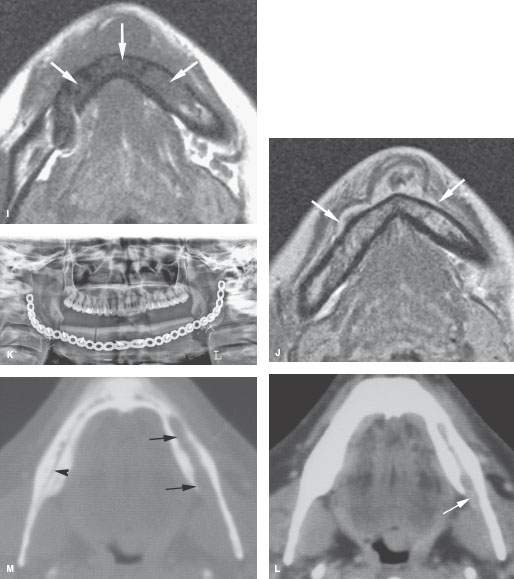
FIGURE 200.9. Three patients to illustrate varying patterns of bone erosion involving the alveolar ridge and mandible. A–E: Patient 1. Contrast-enhanced computed tomography (CT) of a very limited floor of the mouth cancer (arrow in A). In (B) and (C), there is erosion of the alveolar ridge along the lingual plate of the mandible (arrow) and extension along the incisor tooth socket that could have been due to tumor or periodontal disease. That alveolar ridge extension was confirmed on the sagittal reformatted image in (D) compared to the normal side on (E). This type of minimal erosion does not constitute T4 staging due to bone invasion. Such spread is consistent with the possibility of mandibular preservation surgery if sufficient bone stock is present. F–K: Patient 2 was 29 years old and presented with rapidly progressive swelling at the mandibular symphysis. In (F), CT shows a nodular soft tissue mass, with an intraoral and premandibular component (arrows). In (G), bone windows show that apart from some dense bone trabeculae in the midline (arrows), no bone abnormalities were detectable. In (H), the axial CT image at soft tissue windows shows nodular components (arrowheads) and the mass also infiltrating tissues along the mandibular body further distally (arrows). In (I), the T1-weighted (T1W) axial image shows the soft tissue components as well as signal loss in the medullary cavity of the mandible (arrows). The bony abnormalities visible on magnetic resonance were more extensive than seen on CT, nearly reaching the mandibular angle on both sides. In (J), the gadolinium- enhanced T1W image confirms perimandibular extension of tumor (arrows). The intramandibular component shows enhancement and is now less discernable from the normal medullary bone more distally. In (K), postoperative panoramic radiography shows the extent of mandibular resection. Pathologic examination showed that the tumor was within 3 mm of the distal lines of resection. L, M: A patient with neurofibrosarcoma of the mandibular nerve infiltrating the inferior alveolar nerve along its canal and at the mandibular foramen (arrows) compared to the normal side (arrowheads).
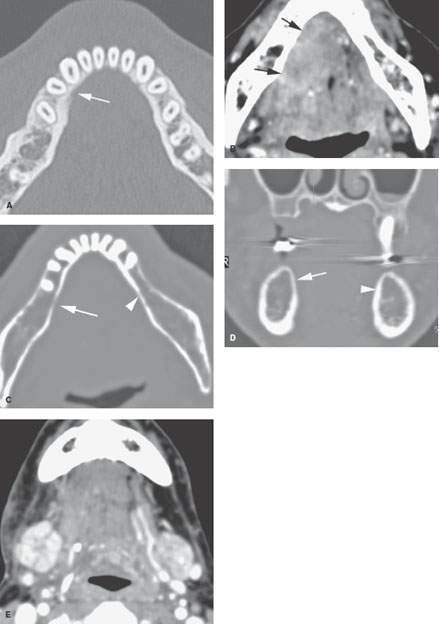
FIGURE 200.10. Two patients demonstrating difficulties in assessing subtle areas of bone erosion. A: Patient 1. Bone windows showing slight irregularity (arrow) along the cortex of the lingual plate of the mandible in a patient with a nearby floor of the mouth (FOM) cancer that clinically was not involving the mandible. This is a normal variation called a furcation. B–E: Patient 2. Contrast-enhanced computed tomography showing a fairly extensive FOM carcinoma with a broad base along the length of the surface of the mandible (arrows in B). In (C), there is only very subtle demineralization of the lingual plate (arrow) compared to the normal opposite side (arrowhead). This thinning is even more subtle in (D) on the coronal reformatted image (arrow) compared to the normal side (arrowhead). (NOTE: This was a fairly aggressive primary tumor, and the subtle bone loss demonstrates the relatively resistant nature of the periosteum along the lingual plate of the mandible to bone erosion. Bone erosion was confirmed, and the patient required segmental resection of the mandible for an oncologically adequate resection.) In (E), this tumor, being bilateral anteriorly in the FOM, had obstructed both distal submandibular ducts, resulting in sialoadenitis in both submandibular glands that mimicked adenopathy. This study clearly shows no level 1 adenopathy and bilateral obstructive sialoadenitis changes.
Stay updated, free articles. Join our Telegram channel

Full access? Get Clinical Tree







